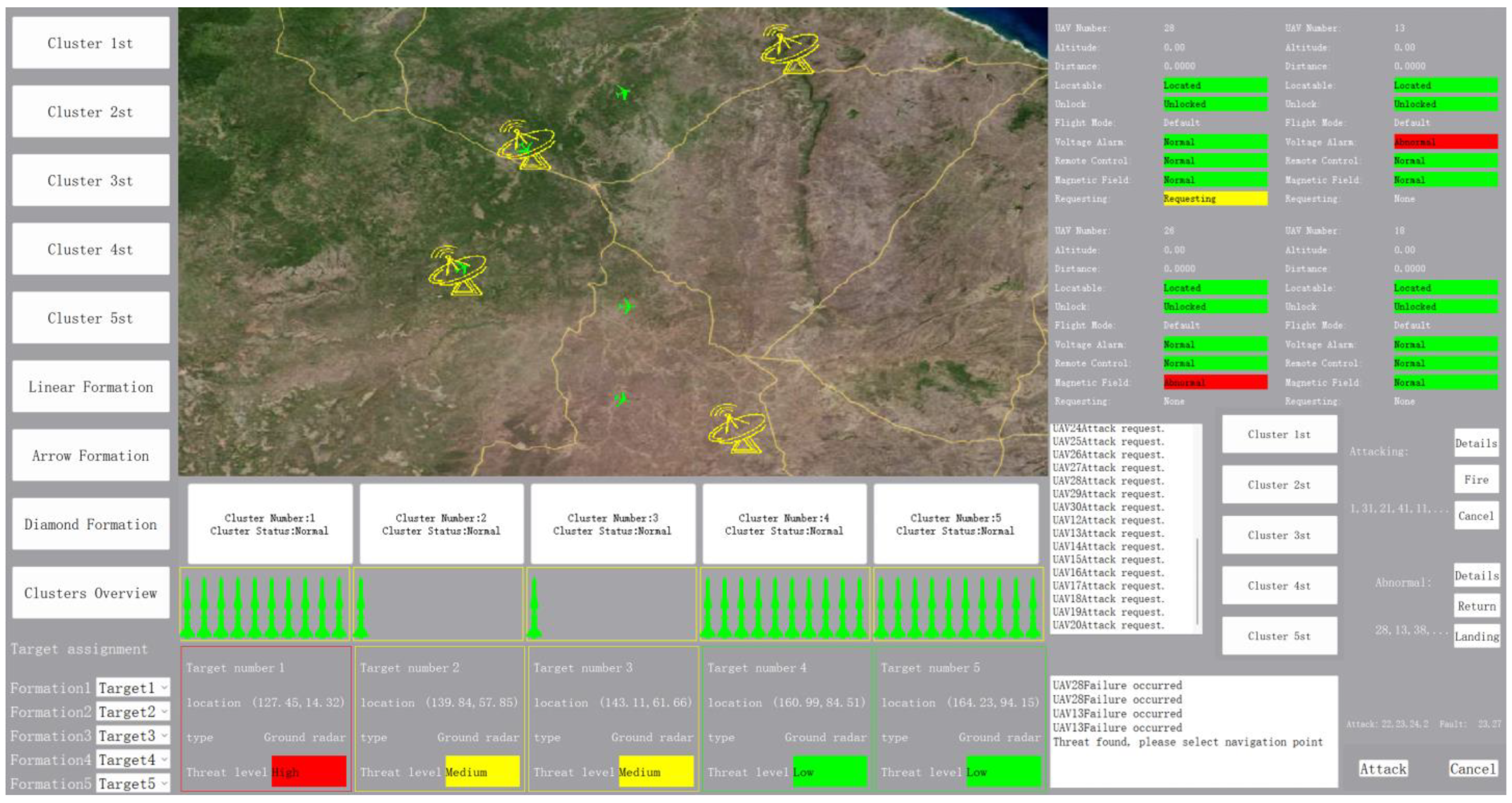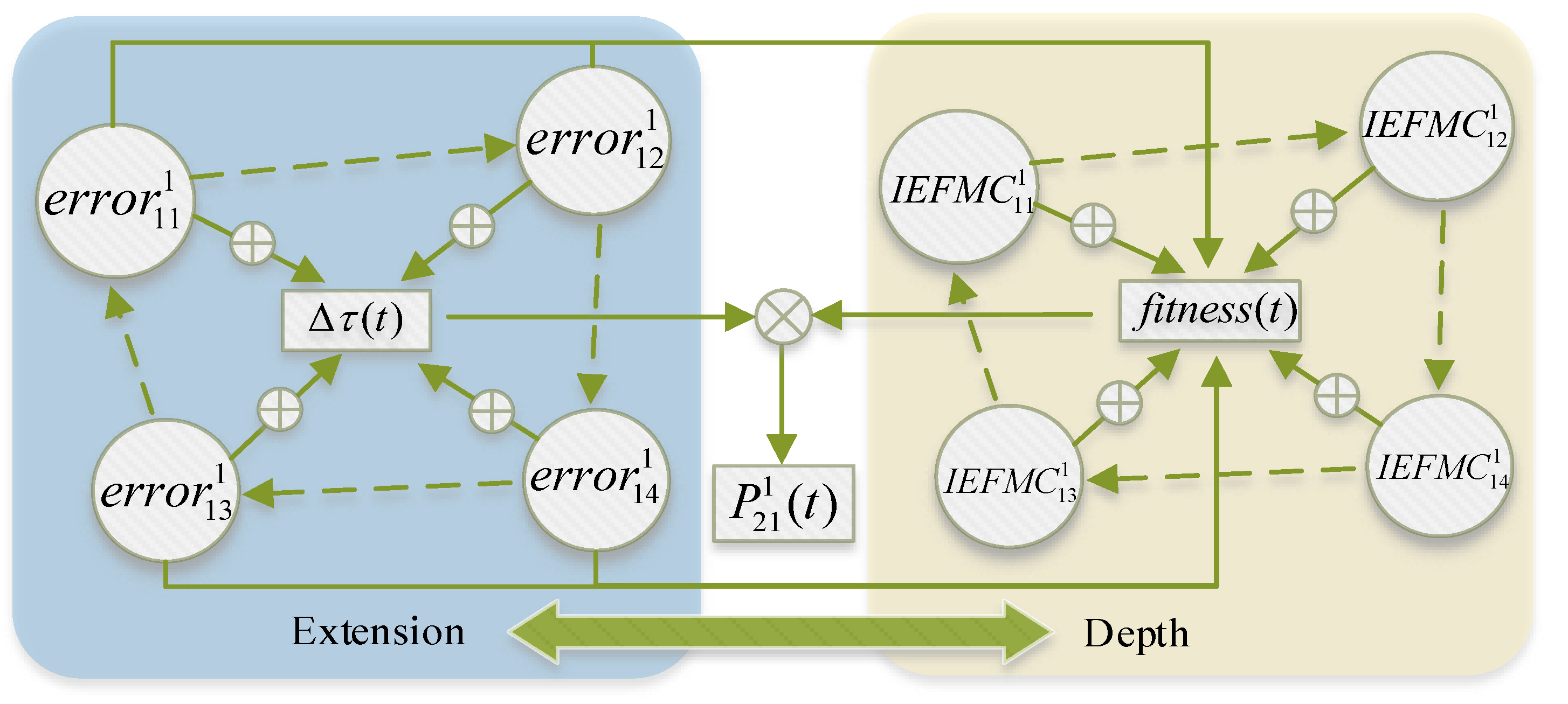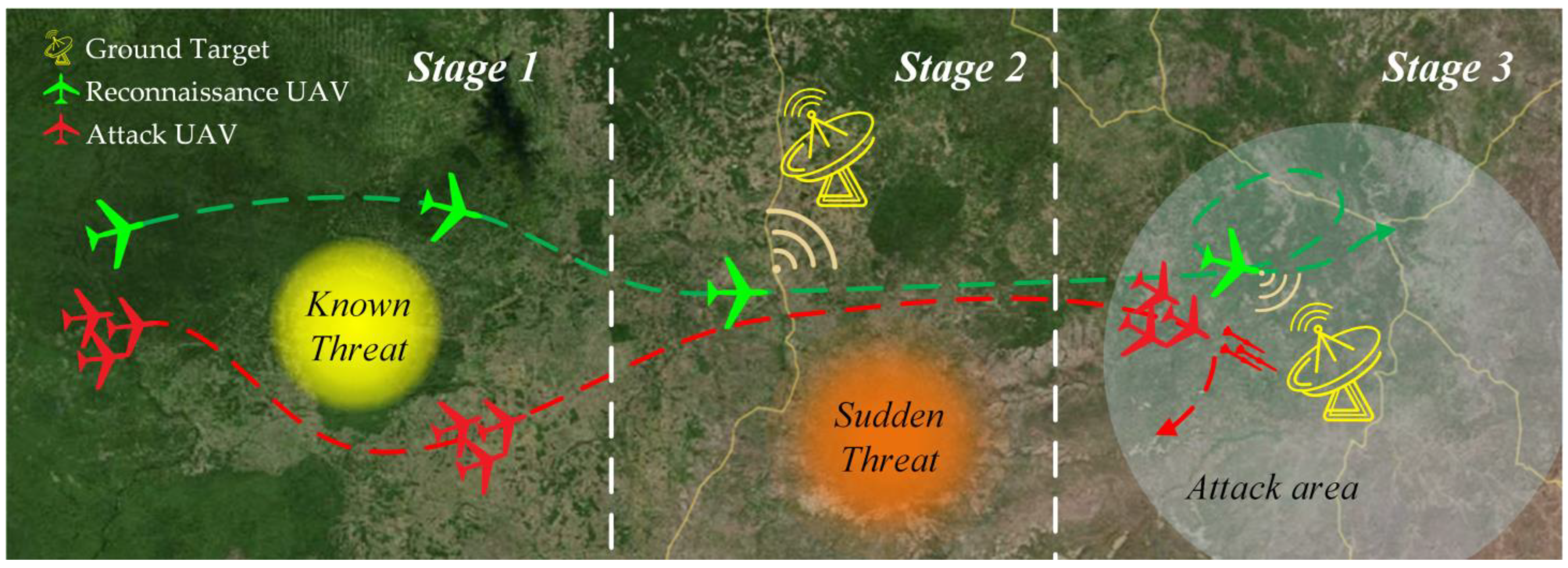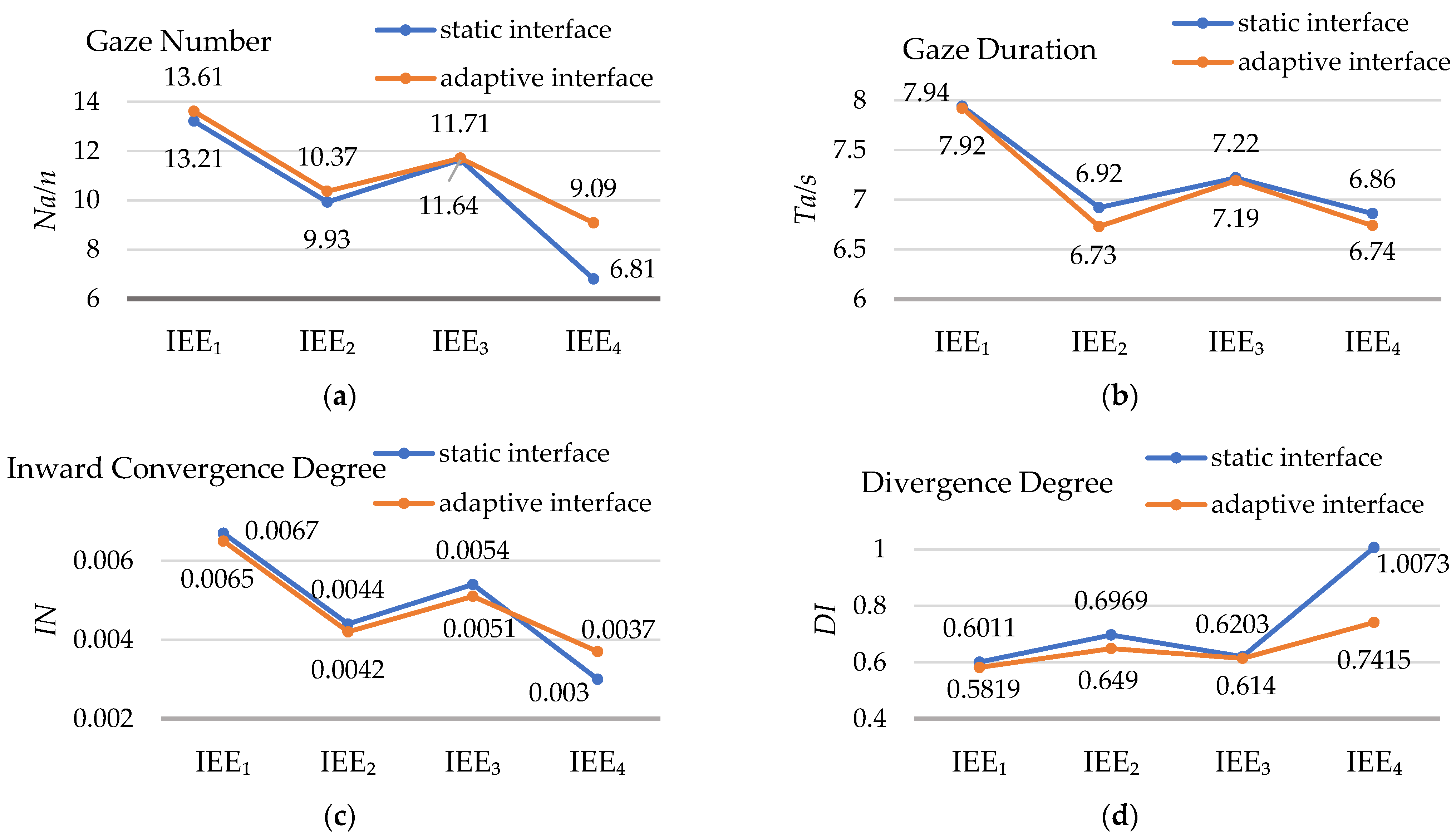Intelligent Optimization Method of Human–Computer Interaction Interface for UAV Cluster Attack Mission
Abstract
:1. Introduction
- This paper proposes a comprehensive multi-dimensional and multi-factor evaluation method of the HCI interface in GCS under the scenario of a UAV cluster attack control mission. The interface evaluation model incorporating visual attention allocation factors, cognitive psychological characteristics, and attack mission requirements is developed, consisting of five evaluation factors: Salient, Effort, Expectancy, Value, and Cost of interface mutation.
- A SEEV–ant colony algorithm is proposed to establish an implementation method that can adaptively optimize the interface according to the stage of the UAV cluster attack mission.
- A simulated scenario for a typical UAV cluster attack mission is established, and a thorough comparative analysis was conducted between static and adaptive interfaces, focusing on their impact on operators. Utilizing an eye-movement indicator-based model, we assessed interface performance. The results show an 11.59% reduction in operator divergence when using adaptive interfaces in comparison to static ones. Moreover, the evaluation of interface optimization reveals a more than 2.5-fold enhancement in fitness for adaptive interfaces compared to static ones, highlighting a substantial improvement in interface performance.
2. SEEV-Enhanced Interface Evaluation Model
- (A) Quantify the impact factors of interface design, see Section 2.1 for details;
- (B) Establish an interface evaluation model based on the SEEV model, see Section 2.2 for details;
- (C) Quantify the cost of the intelligent optimization process of the interface to the interface evaluation, see Section 2.3 for details;
- (D) The interface evaluation factor is introduced to improve the ant colony algorithm to realize the intelligent optimization of the interface, see Section 3 for details;
- (E) Test the use effect of the intelligent optimized interface, see Section 4.3 for details.
2.1. Geometry and Color Quantization Method of IEE
- (1)
- Military situation map: the function is to display the complex situation, including the map of the battlefield area, the position of our UAV, and the enemy ground targets;
- (2)
- UAV condition monitoring: the detailed information of the four UAVs can be displayed at the same time, including the UAV ID, height, distance, navigation state, flight mode, voltage state, communication state, magnetic field state, and attack mode;
- (3)
- Target information: displays target type, location coordinates, and threat level.
- (4)
- Mission planning: provides interactive functions such as task allocation and attack authorization for the operator, and displays the feedback information of the UAV.
2.1.1. Geometry Definition of IEE
2.1.2. Color Definition of IEE
2.2. Analysis of IEE Based on SEEV
2.2.1. Salient
2.2.2. Effort
2.2.3. Expectancy
2.2.4. Value
2.3. Analysis of the Interface Essential Factor Mutation Cost
3. SEEV-AC Interface Optimization Model
4. Experiments and Results Analysis
4.1. Simulation Environment
- Stage 1: Five of our UAV clusters enter from the left side of the enemy area, and the operator performs route point selection to assist the UAVs in avoiding known threat areas. As shown in Figure 7a, the operator needs to command the UAV formation to select the navigation point to avoid the UAVs entering the threat area. Three navigation points and a known threat area are set up.
- Stage 2: A reconnaissance UAV searches for enemy ground targets and hovers in the target airspace to continuously monitor the target. According to the reconnaissance information, the operator performs tactical planning and target assignment of the UAV cluster to avoid sudden unknown threats. As shown in Figure 7b, after the reconnaissance UAV autonomously searches for the enemy ground target, the operator needs to comprehensively consider the target location, the sudden threat area, and the state of the UAVs to select the ground target attacked by the UAV formation. Five ground targets and three sudden threat areas are set up. After the reconnaissance UAV searches the enemy ground target, one of the three sudden threat areas will appear randomly, and the operator needs to stop the UAVs entering the threat area.
- Stage 3: The UAV cluster carries out air strikes on the ground targets, and the operator processes the attack request. As the formation of UAVs approaches a designated ground target, an established attack zone is activated. Once the UAV enters this attack zone, they generate an attack request, which undergoes a brief processing period lasting 3 s. It is imperative for the operator to promptly issue the attack command during this interval. Subsequently, the UAV formation performs an attack on the designated target, and then autonomously initiates the return phase. If the operator fails to issue the attack command within the prescribed time frame, the UAVs will proceed directly to their return phase.
4.2. Analysis of SEEV-AC Intelligent Interface Optimization Model
4.3. Performance Evaluation and Comparison
- The subjects use the three interfaces of Figure 9a–c to complete the corresponding stages of the UAV cluster attack mission; this interface is defined as an adaptive interface. The update latency of the adaptive interface is within 5 ms.
- The subjects only use the interface of Figure 9a to complete the UAV cluster attack mission, this interface is defined as a static interface.
5. Discussion
6. Conclusions
Author Contributions
Funding
Data Availability Statement
Conflicts of Interest
References
- Xiang, X.J.; Tan, Q.; Wang, C.; Zhou, H.; Tang, D.Q.; Niu, Y.F. Survey on Key technologies of UAV advanced ground stations. J. Natl. Univ. Def. Technol. 2023, 45, 1–14. [Google Scholar]
- Zhang, J.; Zhao, X.; Wang, X. Man-machine Ergonomics Evaluation of Static Operation Interface of UAV Ground Station. J. Aircr. Des. 2020, 40, 49–53+64. [Google Scholar]
- Lang, W.M.; Zhou, L.; Wang, Z.Y.; Yao, J.F.; Fei, Y.X. Research on ground control station of unmanned aerial vehicle. J. Telecommun. Inf. 2021, 604, 1–7. [Google Scholar]
- Jiang, H.; Gao, X. Application and Prospect of Human Factor Engineering in Unmanned Aerial Vehicle. J. Aeronaut. Sci. Technol. 2019, 30, 9–13. [Google Scholar]
- Chen, S.G.; Li, Z.Z.; Ge, L.Z.; Zhang, J.Y.; Wang, C.H. Research Progress and Development Suggestions on Human Factors Engineering. J. Bull. Natl. Nat. Sci. Found. China 2021, 35, 203–212. [Google Scholar]
- Lin, Q.; Wang, Y.X.; Cai, Z.J.; Wu, K. Statistics and analysis of several types of UAV accidents abroad. In Proceedings of the 5th Proceedings of China UAV Conference, Beijing, China, 15 September 2014. [Google Scholar]
- Hocraffer, A.; Nam, C.S. A meta-analysis of human-system interfaces in unmanned aerial vehicle (UAV) swarm management. Appl. Ergon. 2017, 58, 66–80. [Google Scholar] [CrossRef]
- Wu, X.L.; Zhang, L.; Niu, J.R.; Liu, X.; Han, W.Y. Review of Display Control Interaction and Man-machine Coordination in Fighter Cockpit. J. Packag. Eng. 2022, 43, 1–13. [Google Scholar]
- Ye, K.; Bao, H.; Wei, S. Layout Optimization for Aircraft Cockpit Man-Machine Interface Based on Visual Attention Distribution. J. Nanjing Univ. Aeronaut. Astronaut. 2018, 50, 416–421. [Google Scholar]
- Yang, K.; Gao, W.; Bai, J. Research on the Evaluation of Flight Instruments Layout Based on Eye Movement Indices. Chin. J. Ergon. 2016, 22, 1–6. [Google Scholar]
- Jin, Y.T.; Lu, J.; Pan, W.J.; Zhao, Z.J.; Liu, X. Layout Optimization of Virtual Interface Based on Visual Attention Mechanism. Comput. Eng. Des. 2020, 41, 763–769. [Google Scholar]
- Wu, X.; Xue, C.Q.; Wang, H.Y. E-C Mapping Model for Human Computer Interaction Interface of Complex System. J. Mech. Eng. 2014, 50, 206–212. [Google Scholar] [CrossRef]
- Wang, D.Y.; Qu, J.; Wang, W. Optimization design and evaluation of interface layout of display console of air defense and anti-missile equipment command module. J. Air Force Eng. Univ. 2021, 22, 104–111. [Google Scholar]
- Zhang, J.M.; Fu, J. Research on human machine analysis and JACK simulation optimization of tractor user interface. Agric. Mech. Res. 2022, 44, 244–250. [Google Scholar]
- Deng, L.; Wang, G.H.; Yu, S.H. Layout design of human-machine interaction interface of cabin based on cognitive ergonomics and GA-ACA. Comput. Intell. Neurosci. 2016, 3, 1–12. [Google Scholar] [CrossRef] [PubMed]
- Kang, H.; Yang, S.X.; Deng, S.W. Multi-objective design optimization of the layout of product interface elements. Packag. Eng. 2020, 41, 149–153+172. [Google Scholar]
- Zhang, B.; Ding, M.; Li, Y.J. Optimized design of human-computer interaction interface based on visual perception intensity. China Mech. Eng. 2016, 27, 2196–2202. [Google Scholar]
- Chen, L.; Lu, J.; Pan, W.J.; Liu, X. User Interface Layout Optimization Incorporating Cognitive Load. Comput. Syst. Appl. 2022, 31, 307–315. [Google Scholar]
- Yan, S.; Chen, Y.; Chen, W. Research on complex human-machine interface safety evaluation for main control room of nucleal power plant. China Saf. Sci. J. 2014, 24, 62–67. [Google Scholar]
- Zhao, Z.J.; Lu, J.; Jin, Y.T.; Ji, W.Y.; You, Q. Optimization of Operating Interface Layout of Ant Colony Algorithm Driven by Human Factor Features. J. Modul. Mach. Tool Autom. Manuf. Tech. 2020, 555, 124–127+131. [Google Scholar]
- Ilysa, Q.M.; Ahmad, M.; Zaman, N.; Alshamari, M.A.; Ahmed, I. Localized Text-Free User Interfaces. IEEE Access 2022, 10, 2357–2371. [Google Scholar] [CrossRef]
- Wu, L.Z.; Niu, Y.F.; Wang, C.; Fang, B. Design and Practice of Supervisory Control System for Multiple Unmanned Aircraft Systems. Unmanned Syst. Technol. 2020, 3, 42–52. [Google Scholar]
- Zhang, G.; Peng, H.; Niu, Y.F. Architecture Analysis and Design of Multiple UAVs Supervisory Control System. J. Syst. Simul. 2010, 22, 138–141. [Google Scholar] [CrossRef]
- Wickens, C.D.; Alexander, A.L. Attentional tunneling and task management in synthetic vision displays. Int. J. Aviat. Psychol. 2009, 19, 182–199. [Google Scholar] [CrossRef]
- Bo, C.; Wei, W.; Jue, Q. Discussion on adaptive man-machine function allocation mechanism of UAV ground station. J. Aerosp. Technol. 2016, 376, 52–54+88. [Google Scholar]
- Schvaneveldt, R.W.; Beringer, D.B.; Lamonica, J.A. Priority and organization of information accessed by pilots in various phases of flight. Int. J. Aviat. Psychol. 2001, 11, 253–280. [Google Scholar] [CrossRef]
- Zarali, F.; Yazgan, H.R.; Delice, Y.A. New solution method of ant colony-based logistic center area layout problem. Sadhana 2018, 43, 83–99. [Google Scholar] [CrossRef]
- Srikakulapu, R.; Vinatha, U. Optimized design of collector topology for offshore wind farm based on ant colony optimization with multiple travelling salesman problem. J. Mod. Power Syst. Clean Energy 2018, 6, 1181–1192. [Google Scholar] [CrossRef]
- Zhu, H.T.; Liu, X.; Ma, G.J.; Li, S.Y.; Gan, Y.H. An Improved Route Planning Method for Cruise Missile Cluster Based on Area Sealing and Control Expansion. J. Proj. Rocket. Missiles Guid. 2022, 42, 114–118. [Google Scholar]
- Li, R.Q.; Wu, S.F.; Fen, Z.T.; Gao, X.; Wang, J.Y. Sheet metal layout algorithm based on ant colony algorithm and rectangle method. Mach. Des. Manuf. Eng. 2021, 50, 72–76. [Google Scholar]
- Chen, A.Q.; Bai, W.B.; Chen, J.; Xie, F. Performance Evaluation Model of Human-Machine Interactions for UAV Cluster Attack. In Proceedings of the International Conference on Autonomous Unmanned Systems, Xi’an, China, 23–25 September 2022. [Google Scholar]
- Chen, J.; Bai, W.B.; Li, Z.L.; Chen, S. An Information Overload Containment Method for Operators Facing Multi-UAVs Supervisory Control Task. J. Unmanned Syst. Technol. 2022, 5, 21–30. [Google Scholar]
- Li, G.; Li, H.; Zhang, S.Y. Optimal path planning and parameter analysis based on ant colony algorithm. J. China Sci. Pap. 2018, 13, 1909–1914. [Google Scholar]
- Wang, H.B.; Xue, C.Q.; Huang, J.W.; Song, G.L. Design and Evaluation of Human-computer Digital Interface Based on Cognitive Load. Electro-Mech. Eng. 2013, 29, 57–60. [Google Scholar]











| Priority | Quantized Value | Information Category |
|---|---|---|
| 1 | 0.8 | Map and route, Radar, Situation information |
| 2 | 0.6 | Threat point information, Target information, Speedometer, Altimeter, Attitude instrument |
| 3 | 0.4 | UAV status information, Weapon status, Mission list, Latitude-longitude |
| 4 | 0.2 | External vision, flight distance, flight time, climate |
| IEE Type | Stage 1 | Stage 2 | Stage 3 | |||
|---|---|---|---|---|---|---|
| W | V | W | V | W | V | |
| Military situation map | 5 | 0.8 | 5 | 0.8 | 7 | 0.8 |
| UAV condition monitoring | 3 | 0.4 | 1 | 0.4 | 3 | 0.4 |
| Target information | 1 | 0.6 | 5 | 0.6 | 1 | 0.6 |
| Mission planning | 1 | 0.4 | 3 | 0.4 | 5 | 0.4 |
| Parameter | Value | Parameter | Value |
|---|---|---|---|
| 2 | 0.3 | ||
| 2 | M | 300 |
Disclaimer/Publisher’s Note: The statements, opinions and data contained in all publications are solely those of the individual author(s) and contributor(s) and not of MDPI and/or the editor(s). MDPI and/or the editor(s) disclaim responsibility for any injury to people or property resulting from any ideas, methods, instructions or products referred to in the content. |
© 2023 by the authors. Licensee MDPI, Basel, Switzerland. This article is an open access article distributed under the terms and conditions of the Creative Commons Attribution (CC BY) license (https://creativecommons.org/licenses/by/4.0/).
Share and Cite
Chen, A.; Xie, F.; Wang, J.; Chen, J. Intelligent Optimization Method of Human–Computer Interaction Interface for UAV Cluster Attack Mission. Electronics 2023, 12, 4426. https://doi.org/10.3390/electronics12214426
Chen A, Xie F, Wang J, Chen J. Intelligent Optimization Method of Human–Computer Interaction Interface for UAV Cluster Attack Mission. Electronics. 2023; 12(21):4426. https://doi.org/10.3390/electronics12214426
Chicago/Turabian StyleChen, Anqi, Feng Xie, Jingbo Wang, and Jun Chen. 2023. "Intelligent Optimization Method of Human–Computer Interaction Interface for UAV Cluster Attack Mission" Electronics 12, no. 21: 4426. https://doi.org/10.3390/electronics12214426
APA StyleChen, A., Xie, F., Wang, J., & Chen, J. (2023). Intelligent Optimization Method of Human–Computer Interaction Interface for UAV Cluster Attack Mission. Electronics, 12(21), 4426. https://doi.org/10.3390/electronics12214426






